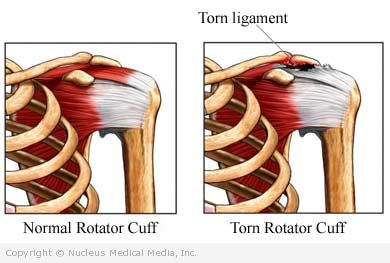Rotator cuff injury
(Rotator Cuff Tear; Impingement Syndrome)
Rotator cuff injury – Definition
Rotator cuff injury may include tendinitis, strain, or tear of the rotator cuff. The rotator cuff is made up of muscles and four separate tendons that fuse together to surround the shoulder joint.
Rotator cuff injury – Causes
Causes of a rotator cuff injury include:
- Direct blow to the shoulder area
- Falling on an outstretched arm
- Chronic degenerative wear and tear on the tendons:
- Arthritis may decrease the space for the tendons
- Chronic instability of the humerus may traumatize the tendons
- Repetitive overhead motion of the arm such as in:
- Swimming
- Baseball (mainly pitching)
- Tennis
Rotator cuff injury – Risk Factors
A risk factor is something that increases your chance of getting a disease or condition. Risk factors for a rotator cuff injury include:
- Age: 40 or older
- Heavy lifting
- Activities that involve repetitive overhead arm motion
- Weakened shoulder muscles from inactivity or previous injury
Rotator cuff injury – Symptoms
- Recurrent, constant pain, particularly when reaching overhead
- Pain at night that prevents you from sleeping
- Shoulder muscle weakness, especially when lifting the arm
- Popping or clicking sounds when the shoulder is moved
- Limited range of motion in the shoulder joint
Rotator cuff injury – Diagnosis
The doctor will ask about your symptoms and medical history. A physical exam will be done. The doctor will carefully examine your shoulder. You will be asked to move your shoulder in several directions.
Tests may include:
- X-rays
- Arthrogram
- MRI
- Arthroscopy
- Ultrasound
Rotator cuff injury – Treatment
The treatment will depend on the extent of your injury, level of pain, and amount of immobility. The first step is usually a nonsurgical approach.
Nonsurgical
- Rest — to help the shoulder heal. The doctor may recommend that you wear an arm sling to help rest the shoulder area.
- Nonsteroidal anti-inflammatory drugs (NSAIDs) — to help control the pain if there is inflammation
- Topical pain medicines (eg, cream, patches) that are applied to the skin
- Corticosteroid injections — to help reduce swelling and pain
- Injection of platelet rich plasma (PRP)
- Ice — to help reduce swelling and pain. Apply ice to shoulder area for 15 minutes, 3 to 4 times a day.
- Physical therapy — to help strengthen and increase motion in the shoulder area
Surgical
Acromioplasty
This involves surgery on the bony structures that impinge the rotator cuff. It can be arthroscopic or open.
Arthroscopy
A small instrument is inserted into the shoulder and used to remove bone spurs or degenerated portions of the rotator cuff tendons. Lesser tears can be repaired during arthroscopy as well.
Mini-Open Repair with Arthroscopy
This combines arthroscopy with an incision in the shoulder joint. Through the incision, the doctor can suture larger tears in the tendons.
Open Surgery
This is used to repair the injured tendon in more severe cases. A tissue transfer or a tendon graft can be done during surgery if the tear is too large to be closed together. In the most severe cases, a joint replacement may be necessary.
Rotator cuff injury – Recovery
Depending on the extent of your injury, full recovery can take anywhere from two to six months, and sometimes longer.
If you are diagnosed with a rotator cuff injury, follow your doctor’s instructions.
Rotator cuff injury – Prevention
To reduce your chances of getting a rotator cuff injury:
- Avoid overhead repetitive motion.
- Avoid heavy lifting.
- Exercise regularly to strengthen the muscles around the shoulder joint.

